Leptodactylodon axillaris is a species of frog in the family Arthroleptidae. It is endemic to Cameroon. Its natural habitats are subtropical or tropical moist montane forests, subtropical or tropical high-altitude grassland, rivers, freshwater springs, rocky areas, and heavily degraded former forest. It is only recorded to Mount Bamboutos, West Region, Cameroon and is threatened by habitat loss.

The Uluguru forest tree frog or ruby-eyed tree frog, Leptopelis uluguruensis, is a species of frog in the family Arthroleptidae endemic to Tanzania. Its natural habitats are subtropical or tropical moist lowland forest, subtropical or tropical moist montane forest, rivers, and intermittent freshwater marshes. It is threatened by habitat loss.

Ruiz's robber frog, scientific name Strabomantis ruizi, is a species of frog in the family Craugastoridae. It is endemic to Colombia. Its natural habitat is subtropical or tropical moist montane forest. It is threatened by habitat loss.

Gephyromantis decaryi, commonly known as Decary's Madagascar frog, is a species of frog in the family Mantellidae. It is endemic to Madagascar. Its natural habitats are subtropical or tropical moist lowland forests, subtropical or tropical moist montane forests, and heavily degraded former forest. It is threatened by habitat loss.
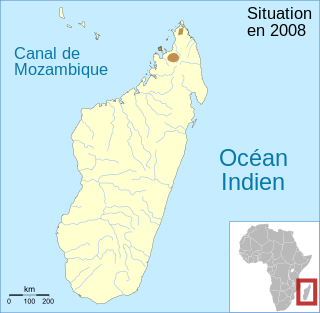
Gephyromantis horridus, commonly known as Boettger's grainy frog, is a species of frog in the family Mantellidae. It is endemic to Madagascar. Its natural habitats are subtropical or tropical moist lowland forests and subtropical or tropical moist montane forests. It is threatened by habitat loss.
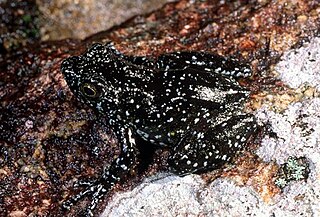
Mantidactylus lugubris is a frog species in the family Mantellidae. It is endemic to Madagascar.
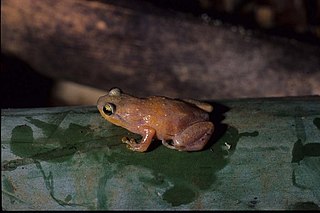
Cophyla berara is a species of frog in the family Microhylidae. It is endemic to Madagascar. Its natural habitat is subtropical or tropical dry forests. It is threatened by habitat loss.
Cophyla phyllodactyla is a species of frog in the family Microhylidae. It is endemic to Madagascar. Its natural habitats are subtropical or tropical moist lowland forests, subtropical or tropical moist montane forests, plantations, rural gardens, and heavily degraded former forest. It is threatened by habitat loss.
Platypelis alticola is a species of frog in the family Microhylidae. It is endemic to Madagascar. Its natural habitat is subtropical or tropical moist montane forests. It is threatened by habitat loss.

Platypelis barbouri is a species of frog in the family Microhylidae. It is endemic to Madagascar. Its natural habitats are subtropical or tropical moist lowland forests, subtropical or tropical moist montane forests, and heavily degraded former forest. It is threatened by habitat loss.
Platypelis cowanii is a species of frog in the family Microhylidae. It is endemic to Madagascar. Its natural habitat is subtropical or tropical moist montane forests.
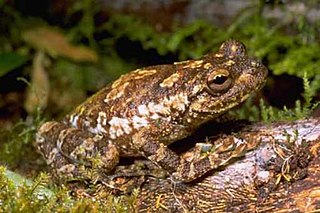
Platypelis grandis is a species of frog in the family Microhylidae. It is endemic to Madagascar. Its natural habitats are subtropical or tropical moist lowland forests and subtropical or tropical moist montane forests. It is threatened by habitat loss. Juveniles are recognizable by the green protuberances on their body, which help them camouflage and hunt. When mature, coloring is brown and green. Insects make up the bulk of their diet.

Platypelis mavomavo is a species of frog in the family Microhylidae. It is endemic to Madagascar. Its natural habitats are subtropical or tropical moist lowland forests and subtropical or tropical moist montane forests. It is threatened by habitat loss.
Platypelis milloti is a species of frog in the family Microhylidae. It is endemic to Madagascar. Its natural habitat is subtropical or tropical moist lowland forests. It is threatened by habitat loss.

Platypelis tuberifera is a species of frog in the family Microhylidae. It is endemic to Madagascar. Its natural habitats are subtropical or tropical moist lowland forests, subtropical or tropical moist montane forests, and heavily degraded former forest. It is threatened by habitat loss.
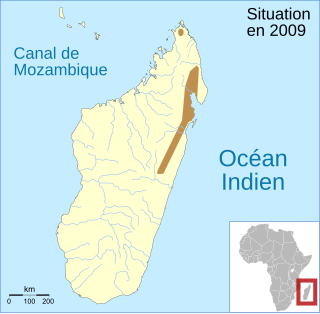
Stumpffia grandis is a species of frog in the family Microhylidae. It is endemic to Madagascar. Its natural habitats are subtropical or tropical moist lowland forests, subtropical or tropical moist montane forests, and heavily degraded former forest. It is threatened by habitat loss.
Stumpffia psologlossa is a species of frog in the family Microhylidae. It is endemic to Madagascar. Its natural habitats are subtropical or tropical moist lowland forests, plantations, and heavily degraded former forest. It is threatened by habitat loss.

Stumpffia pygmaea is a species of frog in the family Microhylidae. It is endemic to Madagascar, where it is known from only two islands, Nosy Be and Nosy Komba. Its natural habitats are subtropical or tropical moist lowland forests, plantations.
Stumpffia tetradactyla is a species of frog in the family Microhylidae. It is endemic to Madagascar. Its natural habitats are subtropical or tropical moist lowland forests and heavily degraded former forest. It is threatened by habitat loss..

Stumpffia tridactyla is a species of frog in the family Microhylidae. It is endemic to Madagascar. Its natural habitats are subtropical or tropical moist lowland forests, subtropical or tropical moist montane forests, and plantations. It is threatened by habitat loss, Stumpffia tridactyla with a snout-vent length of 8.6–12 mm (0.34–0.47 in),Stumpffia tridactyla is a terrestrial microhylid frog, its males average length is 10–11 mm (0.39–0.43 in).













